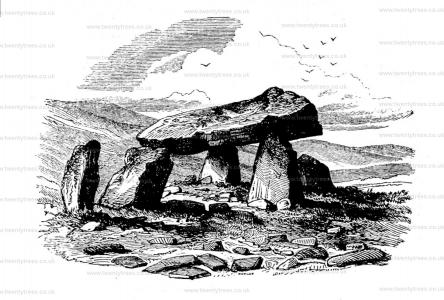Archaeologia Cambrensis 1846 Gaer Llywd Cromlech
Archaeologia Cambrensis 1846 Gaer Llywd Cromlech is in Archaeologia Cambrensis 1846.
Cromlech At Gaerllwyd, Newchurch, Near Caerwent, Monmouthshire [Map].
The relic of antiquity called a Cromlech [Y Garn Llwyd aka Gaer Llywd Long Barrow [Map]], of which a representation is here given, being the only one of the kind in Monmouthshire, and no particulars relating to it having been given by Coxe, Williams, or any of the numerous tourists who have undertaken to describe the more remarkable places in that county, some account thereof, it is deemed, will prove interesting.
The upper or incumbent stone of this ancient relic is twelve feet long, and at a mean, three feet and a half broad; the uprights or supporters are from four to five feet high, and the whole seems to have been surrounded by a slight trench and bank. It is situated on a small farm called Gaer Llwyd, in the parish of Newchurch, on a hill northwards from the town of Caerwent [Map], and distant therefrom, in a direct line, about four miles.
In addition to this, there are several interesting antiquities in the neighbourhood. About a mile from the Cromlech, in the same direction from Caerwent, and in the parish of Llangwm, near its boundary with that of Wolvesnewton, is a very extensive camp, called Gaervawr, and a mile and half westward from thence is another camp, also in the parish of Liangwm, at Golden Hill, formerly called Bryn Eurawg. And about a mile north-east from the Gaervawr is another camp, called Cwrtygaer, in the parish of Wolvesnewton, that gives name to the house and estate on which it is situated; this camp is circular, and thought to be Danish, whereas the others are considered to be British.

The Cromlech was discovered some years ago, by T. Wakeman,Esq. of the Graig, Monmouthshire, who seeing, when at some distance off, what he thought was a cottage, went to it, and was agreeably surprised on finding it different from what he expected. Since then, the account he gave of it has caused it to be visited by several individuals; and when a new road was about to be made in the neighbourhood, he interested himself to preserve it from being broken for road materials, as a Maen Hir, near Monmouth, had shortly before been done for the purpose.
Connected with the subject, the following passage has been supposed to refer to this Cromlech, the great city mentioned therein having been thought to mean Caerwent [Map], and the direction northwards therefrom agreeing with its situation. The passage is extracted from a little work entitled Topography of Monmouthshire, by C. Cooke, published some years ago by Sherwood, Jones, & Co., London. The author, speaking of the Silurian hero, Caractacus, who so long baffled the Roman forces in their invasion of Britain, proceeds as follows: —
"Caruth, the bard, in an Ode to the memory of their Chieftain, says,
The castle of Dinham is consecrated to his memory,
It riseth near his grave. In the ancient lore
Of the learned, thus it is written, On the mount
Which lieth north of the great city, there sleeps
Caractacus, till God, the God of Bran, appears
On earth."
Should, however, the monument not be thought to be the resting place of the celebrated Caractacus, it may, notwithstanding, cover the remains of some British chieftain of ancient days, who fell in battle, of which the camps are the only record. At all events the subject is interesting, and worthy of investigation.
Abaris.
[We understand that the person in occupation of the land upon which this cromlech stands, was so much annoyed at the number of visitors who came to see it, that he threatened to pull it down and destroy it. A gentleman, however, in the neighbourhood, distinguished for his love of antiquities, has interfered, and we hope with success. It cannot be too strongly impressed upon the nobility and gentry of the land that they are, by virtue of their station, the natural conservators of the historical monuments of their country, and that they are bound to protect them, even at the expense of their money and their leisure. Disrespect for ancient things and ancient institutions becomes easily associated in the minds of the uneducated many, with contempt and disaffection for existing monuments and laws; and the pathway to change and destruction, which mankind are so fond of treading, is thereby rendered only the broader. Every stone wantonly pulled out of an old building, every chip knocked off a cromlech, indicates a step taken in the wrong direction.— Edd. Arch. Cambr.]